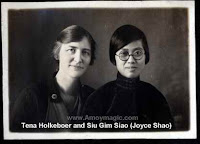Many Chinese & foreigners query about ancestors in old Amoy (former name of Xiamen). Today, a lady from WLRN Public Radio & Television, Miami, Florida, inquired about the house at #32 Fujian Rd. (she actually wrote #3 Lujiao Rd., but the photo was of Huang Rongyuan Mansion at #32 Fujian Rd). Since others have also inquired about this estate, which is right beside the Spanish Gothic Catholic Church and former Japanese consulate, police station and jail, I am posting my reply online. This description is from my book Discover Gulangyu! 魅力鼓浪屿, Xiamen University Press (I have 10 books now on Xiamen and Fujian Province, and hope to get them converted soon to e-Book format). Enjoy Amoy! Dr. Bill
#32 Fujian Rd Huang Rongyuan Mansion (黄荣远堂), circa 1920, is directly opposite Sea and Sky Palace. The villa reminds me of antebellum mansions in the Deep South—though no Southerner ever had a garden like this, with its towering palms, shimmering pool, and Chinese pavilion and rockery to the left, from which you can snap a photo of the Spanish Gothic Catholic Church on the other side of the wall.
Huang Rongyuan Villa was designed by a Filipino architect and built in 1920 by Shi Guangchong, a Philippine overseas Chinese whose ancestral home was Jinjiang, and who was related to one of Gulangyu’s most famous residents. His nephew’s wife was the first daughter of Lin Erjia (林尔嘉), creator of Shuzhuang Garden (菽庄花园).
While Gulangyu was a heavenly place to visit, by the 1930s the Japanese were making it a hell of a place to live in, and in 1937 Mr. Shi hightailed it back to the relatively safety of the Philippines. The villa was taken over by Mr. Huang Zhongxun, who then gave it to his younger brother, Huang Zhongping. He renamed the place Huang Rongyuan Villa, after the real estate company founded by Huang Wenhua (a Nan’an native who made a fortune in developing wilderness in Vietnam), and his son (the same fellow who walled in Sunlight Rock and made it his private garden; read more in the Yongchun Rd. chapter).
Huang Rongyuan Villa is pretty much a Western-style dwelling, with its “Southern mansion” two-story curved front porch and Ionic columns. But few Western homes boast as many styles of windows on one front, and the upper floor, with its dozen or more columns, looks like it was added as an afterthought. Still, I appreciate the imagination that went into its design and construction, and find it astonishing that such a magnificent building was later used as the Deer Reef Kindergarten.
The Spanish Catholic Church (#34 Lujiao Rd.) is on the other side of the garden wall, just across from the former Japanese consulate.
福建路32号:黄荣远堂 大约建于1920年,就在海天堂构的正对面。这座别墅让我想起美国南北战争前南方的住宅——尽管那些南方人都没有这样的花园,园子里是参天的棕榈树,波光粼粼的池面,左边是中式的亭子和假山,在假山上还能抓拍到围墙另一侧的西班牙哥特式天主教堂。
黄荣远堂由菲律宾建筑师设计,菲律宾华侨施光从于1920年建造,施祖籍晋江,他和鼓浪屿的名人菽庄花园的主人林尔嘉还有一些渊源(林的长女为施的侄媳)。
鼓浪屿曾经是个天堂般的旅游胜地,但是在上世纪30年代日本人却把这里变成了人间地狱。1937年,施先生匆忙逃离了鼓浪屿回到相对安全的菲律宾。这座别墅转入黄仲训名下,后来又转给其弟黄仲评。黄仲评将别墅改名为“黄荣远堂”,黄荣远堂是黄文华(南安人,在越南开发荒地致富)和其子(就是那个将日光岩圈为私家花园的家伙,在永春路章节你可以知道更多)创办的房地产公司。
黄荣远堂是一幢以西洋风格为主的建筑,有“南方大宅”的两层拱券和爱奥尼克式的柱子,但很少西式房子在前壁会有这么多各式各样的窗棂,二楼有十几根廊柱,看上去像是后来才添加上去的。不过我仍然颇为欣赏这座房子富有想像力的设计和结构,让我颇为惊讶的是,这座壮观的楼房后来成了鹿礁幼儿园。
西班牙天主教堂(鹿礁路34号)就位于黄荣远堂院子围墙的另一侧,在日本领事馆的正对面。
Bill Brown
Xiamen University
www.amoymagic.com
#32 Fujian Rd Huang Rongyuan Mansion (黄荣远堂), circa 1920, is directly opposite Sea and Sky Palace. The villa reminds me of antebellum mansions in the Deep South—though no Southerner ever had a garden like this, with its towering palms, shimmering pool, and Chinese pavilion and rockery to the left, from which you can snap a photo of the Spanish Gothic Catholic Church on the other side of the wall.
Huang Rongyuan Villa was designed by a Filipino architect and built in 1920 by Shi Guangchong, a Philippine overseas Chinese whose ancestral home was Jinjiang, and who was related to one of Gulangyu’s most famous residents. His nephew’s wife was the first daughter of Lin Erjia (林尔嘉), creator of Shuzhuang Garden (菽庄花园).
While Gulangyu was a heavenly place to visit, by the 1930s the Japanese were making it a hell of a place to live in, and in 1937 Mr. Shi hightailed it back to the relatively safety of the Philippines. The villa was taken over by Mr. Huang Zhongxun, who then gave it to his younger brother, Huang Zhongping. He renamed the place Huang Rongyuan Villa, after the real estate company founded by Huang Wenhua (a Nan’an native who made a fortune in developing wilderness in Vietnam), and his son (the same fellow who walled in Sunlight Rock and made it his private garden; read more in the Yongchun Rd. chapter).
Huang Rongyuan Villa is pretty much a Western-style dwelling, with its “Southern mansion” two-story curved front porch and Ionic columns. But few Western homes boast as many styles of windows on one front, and the upper floor, with its dozen or more columns, looks like it was added as an afterthought. Still, I appreciate the imagination that went into its design and construction, and find it astonishing that such a magnificent building was later used as the Deer Reef Kindergarten.
The Spanish Catholic Church (#34 Lujiao Rd.) is on the other side of the garden wall, just across from the former Japanese consulate.
福建路32号:黄荣远堂 大约建于1920年,就在海天堂构的正对面。这座别墅让我想起美国南北战争前南方的住宅——尽管那些南方人都没有这样的花园,园子里是参天的棕榈树,波光粼粼的池面,左边是中式的亭子和假山,在假山上还能抓拍到围墙另一侧的西班牙哥特式天主教堂。
 |
| Gulangyu Catholic Church |
黄荣远堂由菲律宾建筑师设计,菲律宾华侨施光从于1920年建造,施祖籍晋江,他和鼓浪屿的名人菽庄花园的主人林尔嘉还有一些渊源(林的长女为施的侄媳)。
鼓浪屿曾经是个天堂般的旅游胜地,但是在上世纪30年代日本人却把这里变成了人间地狱。1937年,施先生匆忙逃离了鼓浪屿回到相对安全的菲律宾。这座别墅转入黄仲训名下,后来又转给其弟黄仲评。黄仲评将别墅改名为“黄荣远堂”,黄荣远堂是黄文华(南安人,在越南开发荒地致富)和其子(就是那个将日光岩圈为私家花园的家伙,在永春路章节你可以知道更多)创办的房地产公司。
 |
| Inside Gulangyu Catholic Church |
黄荣远堂是一幢以西洋风格为主的建筑,有“南方大宅”的两层拱券和爱奥尼克式的柱子,但很少西式房子在前壁会有这么多各式各样的窗棂,二楼有十几根廊柱,看上去像是后来才添加上去的。不过我仍然颇为欣赏这座房子富有想像力的设计和结构,让我颇为惊讶的是,这座壮观的楼房后来成了鹿礁幼儿园。
西班牙天主教堂(鹿礁路34号)就位于黄荣远堂院子围墙的另一侧,在日本领事馆的正对面。
Bill Brown
Xiamen University
www.amoymagic.com








